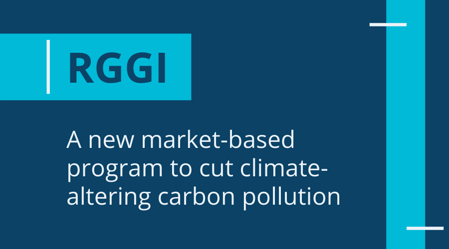
Updated July 13, 2021
North Carolina and Pennsylvania are both moving forward to the next steps related to RGGI. Pennsylvania’s next steps are to present RGGI to the Independent Regulatory Review Commission (IRRC) on September 1st for a potential 2022 entry date while North Carolina has just begun the RGGI rulemaking process with 2023 as their potential entry date.
The Regional Greenhouse Gas Initiative (RGGI or “Reggie”) was established in 2005 and administered its first auction of carbon dioxide emissions allowances in 2008.
RGGI is an initiative of the Northeast and Mid-Atlantic states of the United States that requires fossil fuel power plants with capacity greater than 25 megawatts to obtain an allowance for each ton of carbon dioxide they emit annually.
RGGI states have seen $4.7 billion in net economic benefits from the cap-and-trade program1.
What is RGGI?
It’s considered a new market-based program to cut climate-altering carbon pollution from power plants in 11 Northeast and Mid-Atlantic states – Connecticut, Delaware, Maine, Maryland, Massachusetts, New Hampshire, New Jersey, New York, Rhode Island, Vermont, and Virginia.
It is the first mandatory program in the United States to cap and reduce CO2 emissions from the power sector.
Who is participating?
The original RGGI member states are Connecticut, Delaware, Maine, Maryland, Massachusetts, New Hampshire, New Jersey, New York, Rhode Island, and Vermont.
Virginia joined in early 2021 and New Jersey rejoined RGGI in 2020 after withdrawing from the compact in 2012.
After rejoining, New Jersey set an overall cap reduction of 30% from 2020 to 2030. Revenues from allowances will be spent in four areas: 1) Catalyzing Clean, Equitable Transportation; 2) Promoting Blue Carbon in Coastal Habitats; 3) Enhancing Forests and Urban Forests; and Creating a New Jersey Green Bank.
Also in 2020, Virginia enacted the Virginia Clean Economy Act and amended the Clean Energy and Community Flood Preparedness Act, the latter of which directed its State Air Pollution Control Board to adopt regulations to establish a cap-and-trade program for carbon dioxide emissions. The regulations must comply with the RGGI Model Rule. Virginia will use 95% of the revenue generated from the cap-and-trade program for communities threatened by recurrent flooding and sea level rise (45%) and energy efficiency programs for low-income individuals (50%).
RGGI Goals
The main goal of RGGI is to create an energy efficient economy by reducing carbon emissions from power plants.
This goal also creates a trickle effect into those states participating in RGGI:
- A decrease of other pollutants in addition to carbon including sulfur, nitrogen, particulate matter, and mercury from power plants.
- Creating cleaner air can lead to less health issues in residents of these states.
- Decreasing these pollutants and incentivizing consumers with energy efficient products in these areas will lead to less energy bills.
- By incentivizing consumers in this area, this leads to an increase in installing energy efficient products and leads to creating more jobs for these regions. Other jobs include energy audits, and participating and distributing energy trainers.
All of these lead to creating not only an energy efficient economy but also has economical advantages for these states.
New States
The Governor of Pennsylvania is trying to join RGGI but is facing some challenges. He recently signed an Executive Order that directed the Department of Environmental Protection to begin a rulemaking process that will allow PA to participate in RGGI.
Adoption is expected to take effect in January 2022.
Current Reports of RGGI
Reports have shown a decrease in pollution, electricity prices, and health respiratory issues and an increase in jobs for residents in RGGI states. Even residents of surrounding RGGI states have seen these improvements and economical and environmental advantages.
In a study overlooking RGGI from 2009 to 2014, it has been reported that more than 8,200 asthma attacks have been avoided from the clearer air and over $5.7 billion in health savings and other benefits from states participating in RGGI4.
Summary of Cumulative RGGI Health Benefits, 2009 to 2014
Notes: The total value of avoided health effects is the sum of health benefits in states participating in RGGI
and in neighboring northeastern states, based on a 3 percent rate of discount. Values are in 2015 dollars.
Source: Abt Associates analysis (2017)
If Pennsylvania were to join RGGI, the Department of Environmental Protection (DEP) expects that through 20305:
- Up to 639 premature deaths from respiratory illnesses will be prevented due to emission reductions resulting directly from RGGI participation
- 30,000 fewer hospital visits for respiratory illnesses like asthma for children and adults
These health benefits are a domino effect following the decrease in air pollution. Since the implementation of RGGI, carbon pollution has been cut from power plants in half and the pollution cap is slated to decline by 3% per year through 20306. In addition to carbon pollution, RGGI has also tried to lessen the usage of sulfur, nitrogen, particulate matter, and mercury from power plants. All of these can contribute to health respiratory issues and decreasing the usage of these pollutants has directly correlated to the decrease of asthma attacks and other respiratory systems.
With Pennsylvania potentially participating in RGGI, the DEP estimates that it will reduce pollution from carbon emissions alone by an additional 188 million tons by 20305.
Alongside the health and environmental benefits, there is also an increase of jobs for participating states. These jobs range from full-time, part-time and temporary positions but for participating states in RGGI, this led to over 14,500 new job-years during 2015-20176. These jobs were related to the energy efficiency initiatives and range from energy efficiency installers, distributing energy training, performing energy audits, etc.
The DEP estimates that from 2022 to 2030, Pennsylvania would have a net increase of over 27,000 jobs if part of RGGI5.
The last benefit by the RGGI seems to go back directly to the residents of those states participating in RGGI. Residents in RGGI regions have saved more than $1.1 billion dollars on energy bills so far and will eventually save more than $12 billion on energy over the lifetime of RGGI-funded measures6. All residents, not just those who upgrade to energy efficient products, see savings within their electricity bills. This is due to a lesser need to use power plants from those consumers who purchased and installed energy efficient products. As the demand decreases, the price decreases for all.
Ranging from job increases, lower electricity bills, decrease in pollution, and less health respiratory issues, RGGI states are showing impactful environmental and economical changes. In 2018, a study was prepared to estimate the lifetime benefits of RGGI and it showed 39 million tons of carbon pollutant avoided and over $11 billion in energy bill savings.
All Time Benefits of RGGI Investments
Source: RGGI (July 2020)
These numbers could increase or decrease depending on states reporting year to year or as RGGI grows and more states are added, including Pennsylvania.
The RGGI CO2 cap represents a regional budget for CO2 emissions from the power sector.
The cap for 2021 is 119,767,784 CO2 allowances and the adjusted cap is 100,677,454 CO2 allowances.
Post-2020 cap levels have been established through program review and are detailed in the Principles to Accompany Model Rule Amendments.
On March 15, 2021 RGGI States announced a Third Adjustment for Banked Allowances which is applied to the cap for banked CO2 allowances accumulated through the fourth control period (2018-2020).
Historical Caps, Tracking, and Compliance3
|
Year |
Cap |
Adjusted Cap |
|
2009-2011 |
188 million allowances |
|
|
2012-2013 |
165 million allowances |
|
|
2014 |
91,000,000 |
82,792,336 |
|
2015 |
88,725,000 |
66,833,592 |
|
2016 |
86,506,875 |
64,615,467 |
|
2017 |
84,344,203 |
62,452,795 |
|
2018 |
82,235,598 |
60,344,190 |
|
2019 |
80,179,70 |
58,288,301 |
|
2020 |
96,175,215 |
74,283,807 |
Table data sourced from rggi.org
Notes about this data:
2012-2019 regional cap refers to a nine-state region: CT, DE, ME, MD, MA, NH, NY, RI, VT
All other years refer to a ten-state region: CT, DE, ME, MD, MA, NH, NJ, NY, RI, VT
Two interim adjustments to the cap for banked CO2 allowances accumulated in the first and second control periods.
First Control Period Interim Adjustment for Banked Allowances Announcement
Second Control Period Interim Adjustment for Banked Allowances Announcement
Summary of Proposed Changes to RGGI CO2 Allowance Budget
Each state uses RGGI COATS (a platform that records and tracks data for each state's CO2 Budget Trading Program) to determine compliance with the state’s CO2 budget trading program regulations.
The program is currently in its fifth three-year control period. The control periods are below:
|
Three-Year Control Period |
Start Date |
End Date |
|
Fifth Control Period |
January 1, 2021 |
December 31, 2023 |
|
Fourth Control Period |
January 1, 2018 |
December 31, 2020 |
|
Third Control Period |
January 1, 2015 |
December 31, 2017 |
|
Second Control Period |
January 1, 2012 |
December 31, 2014 |
|
First Control Period |
January 1, 2009 |
December 31, 2011 |
Table data sourced from rggi.org
Compliance is evaluated at the end of each three-year control period. Recently in the last control period RGGI states have also conducted interim compliance (CO2 budget must hold allowances equal to 50% of their emissions during each interim period).
The compliance data reports are available to the public via RGGI COATS.
Other Resources
New York State Energy Research and Development Authority (NYSERDA)
Sources
1 RGGI.org
2 Center for Climate & Energy Solutions (C2ES)
.png?width=500&name=2019%20e%20news%20spotlight%20logo%20(1).png)




